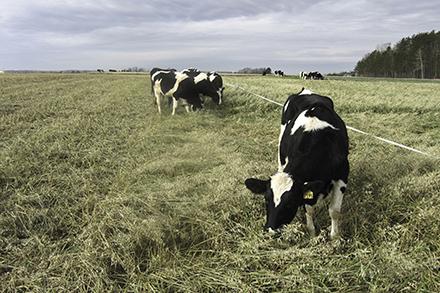ARS Scientists Evaluate Risk of Contaminated Well Water

Residents of Kewaunee County, WI, discovered pollutants in their groundwater. ARS scientists identified dairy cattle as one of the sources of contamination. (Photo by Wayne Coblentz)
Research Data Will Help Planners Make Environmental Decisions
When residents of Kewaunee County, WI, discovered contamination in their private wells, Agricultural Research Service (ARS) scientists went to work to find out why.
Kewaunee County is a rural patch on the shores of Lake Michigan, just east of Green Bay, that boasts an extremely high concentration of cows — about 4.75 cows per human in a population of less than 21,000 — according to data from the University of Wisconsin Applied Population Laboratory and USDA’s Census of Agriculture.
The county draws its water from a fractured Silurian dolomite aquifer, which means that cracks in the rock make it susceptible to contaminants percolating downward from sources on the surface. (Silurian dolomite is limestone that contains magnesium rather than calcium.) When the scientists found that there were contaminants in the water, their natural assumption, with so many cows nearby, was that they came from the dairy industry. But ARS research shows that to be only partly true; while about 33% of well samples contained bovine manure, about 25% were contaminated by septic effluent from residential homes.
Both sources can contribute infectious microorganisms to groundwater, and when that groundwater is used for drinking water, there’s a risk of acute gastrointestinal illness among consumers, including diarrhea and vomiting, said Tucker Burch, an agricultural engineer with the ARS Environmentally Integrated Dairy Management Research (EIDMR) Unit in Marshfield, WI.
“The extent of the health risk hadn’t been quantified well,” he said, “so we are doing this study to put some numbers on that risk, and the results can help guide decisions in the county related to land use, water quality, septic systems, and management of dairy manure.”
The risk assessment is based on earlier sampling of private wells to define the extent of contamination, determine each fecal source, investigate the association of contamination with land use and other county-wide factors, and to estimate health risk.
“Dairy production has changed in many regions of Wisconsin and the United States,” Burch said. “There are many drivers of those changes, and some changes have benefits, others have challenges. Our mission is to study how dairy production and environmental issues affect one another. In many cases that takes the form of more concentrated numbers of dairy cattle (and their manure) on the landscape.”
With this information in hand, the focus of ARS research into the county’s groundwater contamination will shift to the agricultural component and how this might be transferrable to residential septic systems.
“The questions that arise in Kewaunee and elsewhere are things like, is the increased amount of manure in our environment affecting infectious disease in our community?” he said. “If so, what sorts of solutions are there for reducing that effect? It’s about being able to balance agricultural production with environmental quality and to do that in the face of change on both sides of the equation.”
After checking their samples and determining the origin of contaminants, the team began to examine an area no other research has: determining the hazard and risk.
“We’re always trying to make sure we account for both quantities — the degree of exposure and the amount of damage that happens once someone is exposed. In our work, the hazard is waterborne pathogens that come from manure and human wastewater in the environment,” Burch said. “The highest contamination rates (in Kewaunee County) are in areas with thin soils, but very few people have wells drilled there, so the biggest waterborne infectious disease burden is predicted to be in areas with thicker soils; lower contamination rates, but many more people exposed.
“So, the degree of exposure is important, and to quantify it we have to understand the distribution of people on the landscape, in addition to understanding the distribution of the contaminants themselves,” he said.
Burch and his colleagues have a new project and expect that 5-year study to develop a prediction tool to avoid manure runoff contamination of private wells, quantify how pasture management can affect surface runoff water quality, determine the impacts of high-resolution soil mapping on crop nutrients, and develop an exposure and risk assessment model for waterborne gastrointestinal pathogens in private wells.
“This type of study has never been done before like this — the environmental microbiology with risk assessment modeling, land use analysis, and microbial source tracking all together in one study and based on real-world field data,” Burch said.
“I hope this work serves as a starting point to launch similar studies. If we could repeat this type of study in other settings and over time, I think it could add a lot to our ability to balance agricultural production with environmental quality and public health in Wisconsin and other places with large livestock industries.” — By Scott Elliott, ARS Office of Communications.

